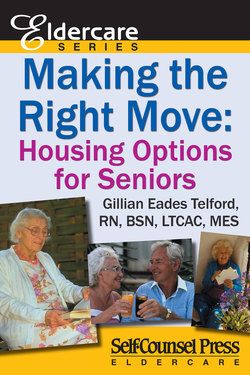Читать книгу Making The Right Move - Gillian Eades Telford - Страница 5
На сайте Литреса книга снята с продажи.
Who This Book Is For
ОглавлениеMaking the Right Move is written for the elder who is considering his or her own future care. However, in many cases, children, spouses, or other relatives either assist in making this choice or are forced to make an independent decision themselves, usually because of a crisis. This book will provide assistance and guidance to both families and elders, giving them specific questions to probe their health care system and helping them to make the best choice to everyone’s satisfaction.
Many elders who have partners are concerned about what will happen when one of them requires additional care. Although most nursing homes have accommodation for at least one couple, usually each elder in the couple has very different needs. For example, one spouse may need special nursing care at odd times of the day and night, and that may disturb his or her roommate. Unfortunately, nursing homes are not very adaptable to this kind of situation in their physical environment or in providing the different levels of care, although they are improving.
More and more multilevel homes are being built that allow couples to be housed in the same complex, if not in the same room or building. The most frequent scenario for couples is that one spouse will enter a nursing home while the other visits daily for long periods. The visiting spouse, or caregiver, still plays an important role as he or she does the extra little things that make life more comfortable for his or her spouse. One of the downsides to this arrangement, however, is that when couples are living as a pair, their pension may be adequate. But when separated, the pension does not cover two places of accommodation. This problem can motivate couples into incredible coping arrangements.
By 2010, 60 percent of people over age 50 will have a surviving parent, compared with only 16 percent in 1960. One of the fears of many elders is that their children will abandon them forever, placing them in a nursing home to die alone and uncared for. This fear along with failing health can make some elders cantankerous. They use all their resources, mental whiles, and emotional blackmail to try to persuade their families that they can live independently.
This emotional turmoil and underlying fear translates into guilt for their families. The process of deciding to place a family member in a nursing home is not easy, especially for the chief caregiver. The caregivers may feel a sense of failure and guilt that they cannot cope any longer. They may also experience a sense of loss because, in many cases, caring for that person has given their lives purpose and meaning. This is especially true of spouses. Many spouses will exhaust themselves to the point of illness rather than enlist formal help.
While families generally share the care of their beloved elders, the majority of the care giving usually falls on one person, most often the daughter or the daughter-in-law. The chief caregiver is the one who will bear the brunt of the emotional warfare that goes on before the decision is made to change housing arrangements.
To ease that tension, try to find out what the elder in your life wants in terms of living arrangements. If his or her expectations are not practical or realistic, then you may need to explain as gently as possible how difficult it is to spend quality time with him or her when you are also having to act as caregiver. Health care professionals advocate the concept of aging in place (see later in this chapter), but it is not possible if the family cannot accommodate the elder. The best plans work when an elder makes a decision in concert with his or her family.
By using this book as a reference to ensure you have made the best choice, you can help allay some of the guilt and frustration of placing someone you love in a nursing home, knowing you have done your best in their best interests.
